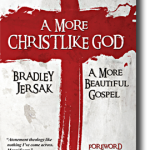Jesus does not look like God; God looks like Jesus.
Let me explain what I mean.
For far too long, Christian theology has allowed a domineering monarchial view of God to discolor and distort our perspective of Jesus. We have an idea of God as the Sovereign King of the universe sitting on His throne in heaven, ruling the poor masses below through sheer power and control. And we have often interpreted Jesus in light of that picture of God. God, up there on His throne, is angry at us for how we rebelled against Him, and so Jesus has come to appease the wrath of God against humanity, which He does by dying on the cross.
Of course, Jesus has a dark side too, and at the end of time, when Jesus comes again, the bloody side of God will be on display in all its glory when Jesus lays waste to the world. So apparently, God is still angry at us, and although the death of Jesus calmed God down for a while, eventually even Jesus gets sick of all the sin, and decides God was right after all.
So you see? We have understood Jesus in light of God.
Thankfully, in recent decades, many pastors, theologians, and authors have begun to challenge this idea of Jesus (and God). Their idea is not new, but is as old as the church itself, and has always been the dominant view of Eastern Christianity. The view is that humanity has been mostly wrong about what God is like, so Jesus came to reveal God to us. Jesus does not look like God; God looks like Jesus.
As we in the West have rediscovered this truth once again, many people are publishing books about it. In recent years I have read dozens of excellent books on the topic. Books by people like C. S. Lewis, N. T. Wright, Walter Wink, Derek Flood, Greg Boyd, and numerous others, have been helpful guides in helping me see that God is Christlike.
A More Christlike God by Brad Jersak
 One of the most recent books I have read on this subject is the new book by Bradley Jersak, A More Christlike God. I love the title, because it makes one realize that many theologies portray a God who is not very Christlike at all. He looks more like Zeus or The Terminator. But in A More Christlike God, Brad Jersak helps us see that God looks like Jesus.
One of the most recent books I have read on this subject is the new book by Bradley Jersak, A More Christlike God. I love the title, because it makes one realize that many theologies portray a God who is not very Christlike at all. He looks more like Zeus or The Terminator. But in A More Christlike God, Brad Jersak helps us see that God looks like Jesus.
Jersak begins his book with several chapters which show how the un-Christlike view of God developed and is taught in Western Christianity. Then, beginning with the concept of self-emptying of God (kenosis) in Philippians 2, he shows how the New Testament paints a portrait of a God who is non-violent, fully loving, self-sacrificial, and completely forgiving.
Jersak’s defense of a Christlike God centers around something he calls “Divine Consent.” The idea is that just as Jesus emptied Himself of His power and position so that He might better love and serve humanity (Philippians 2), so also, God has been emptying Himself of His power and position since creation so that He also might love and serve humanity. One of the ways God did this is by giving humans a degree of genuine freedom. This means, of course, that we might use this freedom in ways God does not want. God could, of course, use His power to stop us from using our freedom in ways He does not want, but then our freedom would not be free. So God empties Himself of His power, and His right to control us, and consents to our misuse of His gift of freedom.
Yet because God knows that our misuse of His gift of freedom results in death and destruction, God doesn’t just say, “You’re going to regret that decision.” Instead, He jumps into the catastrophic consequences of our bad decisions, and works with us to bring hope, healing, restoration, and redemption from the pain and suffering caused by sin. Brad Jersak calls this “Divine Participation.”
 One of the key sections of A More Christlike God is where Brad Jersak discusses the all-important issue of “the wrath of God.” This idea is found in numerous places in the Bible, and is one of the key issues in this debate about what God is like. Many people assume that the phrase “the wrath of God” indicates that God is angry at us. Jersak presents a compelling case for why this is not a proper understanding of that term. He rightly critiques the idea that “the wrath of God” is God withdrawing His mercy. God never withdraws His mercy. God’s mercy is unfailing and everlasting. His mercy endures forever (Psalm 136).
One of the key sections of A More Christlike God is where Brad Jersak discusses the all-important issue of “the wrath of God.” This idea is found in numerous places in the Bible, and is one of the key issues in this debate about what God is like. Many people assume that the phrase “the wrath of God” indicates that God is angry at us. Jersak presents a compelling case for why this is not a proper understanding of that term. He rightly critiques the idea that “the wrath of God” is God withdrawing His mercy. God never withdraws His mercy. God’s mercy is unfailing and everlasting. His mercy endures forever (Psalm 136).
Instead, Jersak defines the wrath of God as “God giving us over” the destructive consequences of our own decisions. As we all know, decisions have consequences. While God seeks to protect us from the consequences of sin through Scripture, wise counsel of friends, and the indwelling Holy Spirit, if we continue down the path of sin and reject His many gifts of mercy, there comes a point where God’s divine consent to our willful rebellion requires Him to let us face the consequences of our decisions.
The book closed with an interesting way of explaining to others the two primary ways of understanding God in the Bible and what Jesus accomplished on the cross. To show this visually, Brad Jersak and Brian Zahnd put together a YouTube video called “The Gospel in Chairs.” Here it is:
Since this video contains the sort of perspective found in this book, I highly recommend you read A More Christlike God.
My only real complaint is that A More Christlike God does very little to help the reader understand the violent texts in the Old Testament. He makes a minor statement on page 17 (through the words of a teenager girl named Jess) that the violence in the Old Testament is not what God did, but only describes what the people thought He was doing. I would have really like a fuller explanation of this idea, especially in how this idea relates to inspiration and inerrancy of Scripture.




kenosis is heresy donotread this book
Paul, your namesake, the Apostle Paul, used the word kenosis in Philippians 2:7. So while you can disagree with what Brad Jersak is saying about Kenosis, you cannot say “kenosis is heresy.” … Unless you are calling Paul a heretic for using the word?
Some Christians,, Jeremy, need to approach Scripture with a locked mind.
Typically, the Pauls in churchianity scream heresy but express no cogent reasons to back up their opinion.
Paul if so much of what Jeremy posts and shares is heresy, why not just leave and stop reading it, Why do you feel the need to keep reading posting and commenting on it. Kenosis is a doctrine widely accepted in Christianity, and depending on how you define it, you may or may not be outside of mainstream theology, but as far as I know, the actual teaching of kenosis is not widely thought to be heretical by any mainline Christian group.
Thanks for pointing this out!
no i am sure that what brad is teaching is that Jesus was not God here on earth which is wrong Jesus was God in the flesh or else all that he did was in vain
Wow. That is quite an assumption. And completely wrong.
Brad does believe that Jesus was God here on earth. I spent 30 seconds searching the internet and found several articles stating his beliefs that Jesus was fully God and fully human during his ministyr.
Here is one: http://www.clarion-journal.com/clarion_journal_of_spirit/2014/10/the-following-summary-represents-what-we-find-in-the-classics-of-early-christian-thought-as-they-recalled-the-faith-once-deli.html
It would be wise in the future to know what you are talking about before you go charging someone with heresy.
I read the book. That’s not what it says. Did you read the book?
Did you read, or are you assuming, because you know what assuming leads to. kenosis simply refers to voluntary laying down or emptying, based on Phil. 2:5 From actually reading the article and also looking at some of Brads work that you are wrong, he is relying heavily on the idea that God and Jesus were one in the same to show that God looks just like Jesus did.
that its no a big revelation of course they were the same but kenosis teaches that Jesus emptied himself of his Godhood and while here on earth was a man which IS a heretical teaching Jesus was fully God and fully man Most people who teach kenosis do not teach this Edwin Pastor FedEx Aldrich
I’ve read several reviews of this book and am curious enough to order a copy, which of course is the idea.
I join Jersak, Enns, Jess and others regarding the violent God. Few things (we know of one) stir up the wrath of those who God needs to defend him (since god apparently is unable to defend himself) more than discussing those texts and the attendant issues of inspiration and inerrancy. The door to that tomb has a sign posted near the entrance that says “Beware, lest all the Christian bookstores in the world ban your books forever more.” I would add to that sign “and lest those who live under the bridge besiege your humble abode.”
I just started reading the book. Many authors I respect endorsed the book. Look forward to reading it and reviewing it on my blog.
Jesus said, “When you’ve seen Me , you’ve seen the Father” correcting the vastly prevalent inaccurate perception of God. It’s amazing how quickly we went right back to this perception.
Jeremy, when you refer to God in this article, are you referring to the Father or to the whole Trinity? If you’re referring to the Father, is it really accurate to say that the Father looks like Jesus? Isn’t the Father his own person? If you are referring to the whole Trinity, then I have some more pondering to do about what you’ve said 😛
Second question. When you talk about Jesus are you thinking about him as he was on earth or as he is in eternity? Can we really interpret things about an eternal Jesus through the narrow lens of his life on earth? Can we not get a fuller understanding of Jesus if we look at him throughout Scripture? For instance, we know that Jesus is creator because of verses like Colossians 1:16, not from things he did and said here on earth. I get the impression that when you talk about Jesus and God, you’re understanding and profiling him based on his earthly life only and interpreting the rest of his existence through that lens. Isn’t that a little dangerous? Please correct me if I’m wrong about my assumptions.
This review is excellent and accurate. Those opposing it simply don’t want to see God’s mercy for all (which is apparent in Paul’s message) and the kindness and forgiveness for all (which is clear by Jesus’ incarnate life.)
Fortunately we can relax in God’s relentless grace and His sovereign hand, knowing that the skeptics of this truth are even part of His plan.